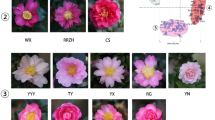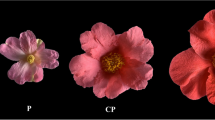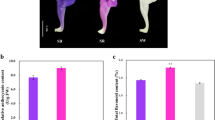Abstract
Cymbidium ensifolium is one of the national orchids in China, which has high ornamental value with changeable flower colors. To understand the formation mechanism of different flower colors of C. ensifolium, this research conducted transcriptome and metabolome analyses on four different colored sepals of C. ensifolium. Metabolome analysis detected 204 flavonoid metabolites, including 17 polyphenols, 27 anthocyanins, 75 flavones, 34 flavonols, 25 flavonoids, 18 flavanones, and 8 isoflavones. Among them, purple-red and red sepals contain a lot of anthocyanins, including cyanidin, pelargonin, and paeoniflorin, while yellow-green and white sepals have less anthocyanins detected, and their metabolites are mainly flavonols, flavanones and flavonoids. Transcriptome sequencing analysis showed that the expression levels of the anthocyanin biosynthetic enzyme genes in red and purple-red sepals were significantly higher than those in white and yellow-green sepals of C. ensifolium. The experimental results showed that CeF3′H2, CeDFR, CeANS, CeF3H and CeUFGT1 may be the key genes involved in anthocyanin production in C. ensifolium sepals, and CeMYB104 has been proved to play an important role in the flower color formation of C. ensifolium. The results of transformation showed that the CeMYB104 is involved in the synthesis of anthocyanins and can form a purple-red color in the white perianth of Phalaenopsis. These findings provide a theoretical reference to understand the formation mechanism of flower color in C. ensifolium.
Key message
This study identified the differential metabolites and differential genes among different color sepals, determined the key regulatory genes, and constructed a regulatory network for the flower color formation of Cymbidium ensifolium.







Similar content being viewed by others
Data availability
The genomic data of C. ensifolium in this study can be found in the National Genomics Data Center (NGDC) at https://doi.org/10.1038/s41438-021-00683-z. RNA-Seq data are openly available at the National Center for Biotechnology Information (NCBI) under the accession number PRJNA771426. The other data presented in this study are available in Supplementary Materials.
References
Ai Y, Li Z, Sun WH, Chen J, Zhang DY, Ma L et al (2021) The Cymbidium genome reveals the evolution of unique morphological traits. Hortic Res 8:264. https://doi.org/10.1038/s41438-021-00683-z
Al Sane KO, Hesham AEL (2015) Biochemical and genetic evidences of anthocyanin biosynthesis and accumulation in a selected tomato mutant. Rend. Fis. Acc. Lincei 26:293–306. https://doi.org/10.1007/s12210-015-0446-x
Alseekh S, Perez de Souza L, Benina M, Fernie AR (2020) The style and substance of plant flavonoid decoration; towards defining both structure and function. Phytochemistry 174:112347. https://doi.org/10.1016/j.phytochem.2020.112347
Chaves-Silva S, Luís dos Santos A, Chalfun-Júnior A, Zhao J, Peres LEP, Benedito VA (2018) Understanding the genetic regulation of anthocyanin biosynthesis in plants—tools for breeding purple varieties of fruits and vegetables. Phytochemistry 153:11–27. https://doi.org/10.1016/j.phytochem.2018.05.013
Chen SM, Li CH, Zhu XR, Deng YM, Sun W, Wang LS, Chen FD, Zhang Z (2012) The identification of flavonoids and the expression of genes of anthocyanin biosynthesis in the chrysanthemum flowers. Biol Plant 56:458–464. https://doi.org/10.1007/s10535-012-0069-3
Chen CJ, Chen H, Zhang Y, Thomas HR, Frank MH, He YH, Xia R (2020) TBtools: an integrative toolkit developed for interactive analyses of big biological data. Mol Plant 13:1194–1202. https://doi.org/10.1016/j.molp.2020.06.009
Ding L (2016) The relative expression and the analysis of key genes associated with the formation of floral color and scent in phalaenopsis type dendrobium. Dissertation, Hainan University
Fossen T, Øvstedal DO (2003) Anthocyanins from flowers of the orchids Dracula chimaera and D. cordobae. Phytochemistry 63:783–787. https://doi.org/10.1016/S0031-9422(03)00339-X
Gao LW, Jiang DH, Yang YX, Li YX, Sun GS, Ma ZH, Zhang CW (2016) De novo sequencing and comparative analysis of two Phalaenopsis orchid tissue-specific transcriptomes. Russ J Plant Physiol 63:391–400. https://doi.org/10.1134/S1021443716020072
Givnish TJ, Spalink D, Ames M, Lyon SP, Hunter SJ, Zuluaga A, Doucette A, Caro GG, McDaniel J, Clements MA, Arroyo MTK, Endara L, Kriebel R, Williams NH, Cameron KM (2016) Orchid historical biogeography, diversification, Antarctica and the paradox of orchid dispersal. J Biogeogr 43:1905–1916. https://doi.org/10.1111/jbi.12854
Hanumappa M, Choi G, Ryu S, Choi G (2007) Modulation of flower colour by rationally designed dominant-negative chalcone synthase. J Exp Bot 58:2471–2478. https://doi.org/10.1093/jxb/erm104
Havsteen BH (2002) The biochemistry and medical significance of the flavonoids. Pharmacol Ther 96:67–202. https://doi.org/10.1016/S0163-7258(02)00298-X
Holton TA, Cornish EC (1995) Genetics and biochemistry of anthocyanin biosynthesis. Plant Cell 7:1071–1083. https://doi.org/10.1105/tpc.7.7.1071
Hsiao YY, Pan ZJ, Hsu CC, Yang YP, Hsu YC, Chuang YC, Shih HH, Chen WH, Tsai WC, Chen HH (2011) Research on orchid biology and biotechnology. Plant Cell Physiol 52:1467–1486. https://doi.org/10.1093/pcp/pcr100
Hsu CC, Chen YY, Tsai WC, Chen WH, Chen HH (2015) Three R2R3-MYB transcription factors regulate distinct floral pigmentation patterning in Phalaenopsis spp. Plant Physiol 168:175–191. https://doi.org/10.1104/pp.114.254599
Hsu CC, Su CJ, Jeng MF, Chen WH, Chen HH (2019) A HORT1 retrotransposon insertion in the PeMYB11 promoter causes harlequin/black flowers in Phalaenopsis orchids. Plant Physiol 180:1535–1548. https://doi.org/10.1104/pp.19.00205
Huang X (2018) Research on molecular regulation mechanism of formation of floral color and floral fragrance of Dendrobium chrysotoxum based on transcriptome sequencing. Dissertation, Chinese Academy of Forestry
Jiang T, Zhang MD, Wen CX, Xie XL, Tian W, Wen SQ, Lu RK, Liu LD (2020) Integrated metabolomic and transcriptomic analysis of the anthocyanin regulatory networks in Salvia miltiorrhiza Bge. flowers. BMC Plant Biol 20:349. https://doi.org/10.1186/s12870-020-02553-7
Ke YJ, Zheng QD, Yao YH, Ou Y, Chen JY, Wang MJ, Lai HP, Yan L, Liu ZJ, Ai Y (2021) Genome-wide identification of the MYB gene family in Cymbidium ensifolium and its expression analysis in different flower colors. Int J Mol Sci 22:13245. https://doi.org/10.3390/ijms222413245
Li CH, Qiu J, Ding L, Huang MZ, Huang SR, Yang GS, Yin JM (2017) Anthocyanin biosynthesis regulation of DhMYB2 and DhbHLH1 in Dendrobium hybrids petals. Plant Physiol Biochem 112:335–345. https://doi.org/10.1016/j.plaphy.2017.01.019
Li WJ, Feng J, Jia WQ, Shen YB (2018) Molecular regulation mechansim of floral color formation in Cymbidium ensifolium. Acta Bot Boreali-Occiden Sin 38:615–623. https://doi.org/10.7606/j.issn.1000-4025.2018.04.0615
Li BJ, Zheng BQ, Wang JY, Tsai WC, Lu HC, Zou LH, Wan X, Zhang DY, Qiao HJ, Liu ZJ, Wang Y (2020) New insight into the molecular mechanism of colour differentiation among floral segments in orchids. Commun Biol 3:89. https://doi.org/10.1038/s42003-020-0821-8
Liu XJ, Chuang YN, Chiou CY, Chin DC, Shen FQ, Yeh KW (2012) Methylation effect on chalcone synthase gene expression determines anthocyanin pigmentation in floral tissues of two Oncidium orchid cultivars. Planta 236:401–409
Liu Y, Tikunov Y, Schouten RE, Marcelis LFM, Visser RGF, Bovy A (2018) Anthocyanin biosynthesis and degradation mechanisms in Solanaceous vegetables: a review. Front Chem 6:52. https://doi.org/10.3389/fchem.2018.00052
Ma H, Pooler M, Griesbach R (2009) Anthocyanin regulatory/structural gene expression in Phalaenopsis. J Am Soc Hortic Sci 134:88–96. https://doi.org/10.21273/JASHS.134.1.88
Meng XQ, Li G, Gu LY, Sun Y, Li ZY, Liu JR, Wu XQ, Dong TT, Zhu MK (2020) Comparative metabolomic and transcriptome analysis reveal distinct flavonoid biosynthesis regulation between petals of white and purple Phalaenopsis amabilis. J Plant Growth Regul 39:823–840. https://doi.org/10.1007/s00344-019-10025-y
Park CH, Yeo HJ, Kim NS, Park YE, Park SY, Kim JK, Park SU (2018) Metabolomic profiling of the white, violet, and red flowers of Rhododendron schlippenbachii maxim. Molecules 23:827. https://doi.org/10.3390/molecules23040827
Tanaka Y, Tsuda S, Kusumi T (1998) Metabolic engineering to modify flower color. Plant Cell Physiol 39:1119–1126. https://doi.org/10.1093/oxfordjournals.pcp.a029312
Tanaka Y, Katsumoto Y, Brugliera F, Mason J (2005) Genetic engineering in floriculture. Plant Cell Tissue Organ Cult 80:1–24. https://doi.org/10.1007/s11240-004-0739-8
Tatsuzawa F, Saito N, Seki H, Yokoi M, Yukawa T, Shinoda K, Honda T (2004) Acylated anthocyanins in the flowers of Vanda (Orchidaceae). Biochem Syst Ecol 32:651–664. https://doi.org/10.1016/j.bse.2004.02.004
Tatsuzawa F, Ichihara K, Shinoda K, Miyoshi K (2010) Flower colours and pigments in Disa hybrid (Orchidaceae). S Afr J Bot 76:49–53. https://doi.org/10.1016/j.sajb.2009.06.017
Wang Z (2015) Isolation and expression of floral color genes in Cattleya and their anthocyanins composition. Dissertation, Chinese Academy of Forestry
Wang L, Albert NW, Zhang HB, Arathoon S, Boase MR, Ngo H, Schwinn KE, Davies KM, Lewis DH (2014) Temporal and spatial regulation of anthocyanin biosynthesis provide diverse flower colour intensities and patterning in Cymbidium orchid. Planta 240:983–1002. https://doi.org/10.1007/s00425-014-2152-9
Wen WW, Alseekh S, Fernie AR (2020) Conservation and diversification of flavonoid metabolism in the plant kingdom. Curr Opin Plant Biol 55:100–108. https://doi.org/10.1016/j.pbi.2020.04.004
Xie QL, Yan F, Chen GP, Hu ZL, Wei SG, Lai JH (2018) Accumulation of anthocyanin and its associated gene expression in purple tumorous stem mustard (Brassica juncea var. tumida Tsen et Lee) sprouts when exposed to light, dark, sugar and methyl jasmonate. Agric Food Chem 67:856–866. https://doi.org/10.1021/acs.jafc.8b04706
Xu WJ, Dubos C, Lepiniec L (2015) Transcriptional control of flavonoid biosynthesis by MYB–bHLH–WDR complexes. Trends Plant Sci 20:176–185. https://doi.org/10.1016/j.tplants.2014.12.001
Yi DB, Zhang HN, Lai B, Liu LQ, Pan XL, Ma ZL, Wang YC, Xie JH, Shi SY, Wei YZ (2020) Integrative analysis of the coloring mechanism of red longan pericarp through metabolome and transcriptome analyses. J Agric Food Chem 69:1806–1815. https://doi.org/10.1021/acs.jafc.0c05023
Yin XJ, Lin XY, Liu YX, Irfan M, Chen LJ, Zhang L (2020) Integrated metabolic profiling and transcriptome analysis of pigment accumulation in diverse petal tissues in the lily cultivar ‘Vivian.’ BMC Plant Biol 20:446. https://doi.org/10.1186/s12870-020-02658-z
Zhang Y, Butelli E, Martin C (2014) Engineering anthocyanin biosynthesis in plants. Curr Opin Plant Biol 19:81–90. https://doi.org/10.1016/j.pbi.2014.05.011
Zhang YY, Zhou TH, Dai ZW, Dai XY, Li W, Cao MX, Li CR, Tsai WC, Wu XQ, Zhai JW, Liu ZJ, Wu SS (2020) Comparative transcriptomics provides insight into floral color polymorphism in a Pleione limprichtii orchid population. Int J Mol Sci 21:247. https://doi.org/10.3390/ijms21010247
Zhao DQ, Tao J (2015) Recent advances on the development and regulation of flower color in ornamental plants. Front Plant Sci 6:261. https://doi.org/10.3389/fpls.2015.00261
Zhou Z, Ying Z, Wu ZG, Yang YP, Fu SB, Xu W, Yao LJ, Zeng AP, Huang J, Lan SR, Wang XL, Liu ZJ (2021) Anthocyanin genes involved in the flower coloration mechanisms of Cymbidium kanran. Front Plant Sci 12:737815. https://doi.org/10.3389/fpls.2021.737815
Funding
This work was supported by The Outstanding Young Scientific Research Talent Project of Fujian Agriculture and Forestry University (no. xjq201910), The Fujian Natural Science Foundation Project of China (2020J01585), The National Key Research and Development Program of China (no. 2019YFD1000400).
Author information
Authors and Affiliations
Contributions
YA conceived and designed the experiments. ZJL, SRL and DHP planned, coordinated and directed the project. YA and QDZ performed the experiments and wrote the manuscript. MJW, LWX, PL, LTG and MYW contributed reagents/materials/analysis tools. All authors have read and agreed to the published version of the manuscript.
Corresponding authors
Ethics declarations
Conflict of interest
The authors declare that they have no competing interests.
Additional information
Publisher's Note
Springer Nature remains neutral with regard to jurisdictional claims in published maps and institutional affiliations.
Supplementary Information
Below is the link to the electronic supplementary material.
Rights and permissions
Springer Nature or its licensor (e.g. a society or other partner) holds exclusive rights to this article under a publishing agreement with the author(s) or other rightsholder(s); author self-archiving of the accepted manuscript version of this article is solely governed by the terms of such publishing agreement and applicable law.
About this article
Cite this article
Ai, Y., Zheng, QD., Wang, MJ. et al. Molecular mechanism of different flower color formation of Cymbidium ensifolium. Plant Mol Biol 113, 193–204 (2023). https://doi.org/10.1007/s11103-023-01382-0
Received:
Accepted:
Published:
Issue Date:
DOI: https://doi.org/10.1007/s11103-023-01382-0




